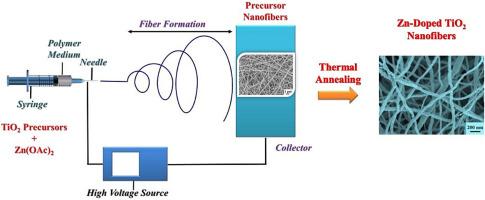电纺丝锌掺杂TiO2纳米纤维:一种高度可重复使用和稳定的降解有机污染物的光催化剂
IF 5.4
3区 化学
Q1 CHEMISTRY, INORGANIC & NUCLEAR
引用次数: 0
摘要
本研究通过流线型电纺丝-热退火工艺成功制备了高性能掺锌TiO2纳米纤维。我们精心优化了合成参数,证明0.02 g醋酸锌浓度和750°C退火温度产生了非常理想的锐钛矿、金红石和ZnTiO3的混合相组成,这对增强光催化活性至关重要。这些优化的纳米纤维在模拟太阳光下对甲基紫和持久性抗生素四环素的降解均表现出非常高的光催化效率。综合表征,包括UV-vis, PL和瞬态光电流分析,明确证实锌掺杂显着拓宽了可见光光谱的光吸收,缩小了带隙,并显着抑制了光生电子-空穴对的重组。自由基俘获和电子自旋共振(ESR)实验进一步证实了超氧自由基阴离子是驱动降解的主要活性物质。关键是,锌掺杂TiO2纳米纤维在多个循环中表现出高可重复使用性和显著的长期稳定性,突出了其鲁棒性。这些发现共同强调了我们优化的锌掺杂TiO2纳米纤维作为一种高效、坚固和可持续的光催化剂的巨大潜力,可用于解决紧迫的环境挑战,特别是在水修复方面。本文章由计算机程序翻译,如有差异,请以英文原文为准。

Electrospun Zn-doped TiO2 nanofibers: A highly reusable and stable photocatalyst for the degradation of organic pollutants
This study successfully fabricated high-performance Zn-doped TiO2 nanofibers through a streamlined electrospinning-thermal annealing process. We meticulously optimized synthesis parameters, demonstrating that a 0.02 g zinc acetate concentration and a 750 °C annealing temperature yielded a highly desirable mixed-phase composition of anatase, rutile, and ZnTiO3, crucial for enhanced photocatalytic activity. These optimized nanofibers exhibited exceptionally high photocatalytic efficiency for degrading both methyl violet and the persistent antibiotic tetracycline under simulated solar light. Comprehensive characterization, including UV–vis, PL, and transient photocurrent analyses, unequivocally confirmed that zinc doping significantly broadened light absorption into the visible spectrum, narrowed the band gap, and remarkably suppressed the recombination of photogenerated electron-hole pairs. Radical trapping and electron spin resonance (ESR) spin-trapping experiments further elucidated that superoxide radical anions were the predominant reactive species driving the degradation. Crucially, the Zn-doped TiO2 nanofibers displayed high reusability and remarkable long-term stability over multiple cycles, highlighting their robustness. These findings collectively underscore the immense potential of our optimized Zn-doped TiO2 nanofibers as a highly effective, robust, and sustainable photocatalyst for addressing pressing environmental challenges, particularly in water remediation.
求助全文
通过发布文献求助,成功后即可免费获取论文全文。
去求助
来源期刊

Inorganic Chemistry Communications
化学-无机化学与核化学
CiteScore
5.50
自引率
7.90%
发文量
1013
审稿时长
53 days
期刊介绍:
Launched in January 1998, Inorganic Chemistry Communications is an international journal dedicated to the rapid publication of short communications in the major areas of inorganic, organometallic and supramolecular chemistry. Topics include synthetic and reaction chemistry, kinetics and mechanisms of reactions, bioinorganic chemistry, photochemistry and the use of metal and organometallic compounds in stoichiometric and catalytic synthesis or organic compounds.
 求助内容:
求助内容: 应助结果提醒方式:
应助结果提醒方式:


